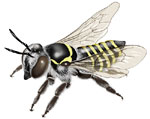Stephen Buchmann is president and founder of The Bee Works and coauthor of The Forgotten Pollinators.

Monday, 22 Sep 2003
TUSCON, Ariz.
It’s Monday morning and I’ve arrived at my office a bit late, feeling rushed and knowing there are plenty of things to do before the day’s over. There will be dozens of emails from friends and colleagues to read and formulate cogent replies to without letting them wait and wonder. I’ve never been a fan of phone tag; with emails you usually know that the message has at least been delivered, has hit the recipient’s electronic desktop. I confess to being addicted to the instant gratification of email, but won’t let it devour more than one hour of any day. I think it’s the best thing since New Zealand Manuka honey drizzled across the pitted face of an English muffin for communicating with far-flung colleagues, family, and friends.
What better way to instantly zing a manuscript plus photographs, tables, figures, and statistical analyses to a scientific colleague halfway around the world? I just did that recently with my engineer, biophysicist, and sometimes pollination researcher and friend, Marcus King, who lives in Christchurch on the south island of New Zealand. Without Internet communication protocols, it would take international snail mail many weeks to get my draft to him, and then many weeks to deliver his reply.
A foreign journal editor has just sent me a Word file, a scientific article on the nesting and foraging behavior of a four-mm-long desert bee. Now, I have but three weeks to decipher, vote yeah or nay as to its acceptance for publication, and reply to the editor with detailed comments, corrections, and suggestions for the authors on improving their manuscript.
Reviewing articles is something scientists are not paid to do. It’s a duty, part of our long scholarly tradition as scientists publishing our work in international journals. Scientists are honor bound to donate some of their time each year serving as pro bono outside reviewers for editors of scientific journals. We also serve as referees to federal and state granting agencies and private foundations and must review their grant proposals and give our opinions on funding. It adds up to a lot of donated time, but without the services of thousands of scientists around the globe, we wouldn’t have the controls of peer-reviewed articles in the primary literature. The quality of the reported research and the essential self-correcting process that is part of the scientific method would also suffer. There would be just unfounded claims like the ones for herbal remedies that cure baldness and give your libido a boost.
I download the paper, send back a quick “I’ll do it” to the editor, and resign myself to bringing the article home and reading it later. Oh, wait, there’s a great email with attached photos from my Brazilian bee researcher and friend, Tony Raw. He’s just become a father and sends his greetings. The beaming smile on the face of the proud papa cradling the newborn in his arms is unmistakable. Those are the kinds of emails I love to get.
Ugh, not another one — the subject line tips me off beforehand. At least two new electronic pleas for me to become the confidant and trusted friend of an unknown representative, the relative of someone formerly in power in Nigeria who now has control of millions of dollars in various unclaimed accounts. How many of them can there be? All I must do to become rich is send them a bit of money and then set up a U.S. bank account and patiently wait for them to dump $30 million into that account. Yeah, right. Old scams never die, they just keep reinventing themselves, especially online. I hit the delete key with gusto.
I’ve got conference agenda documents from the North American Pollinator Protection Campaign to download before our monthly conference call, one that will begin in just 30 minutes. NAPPC is a consortium of more than 70 federal and state agencies, environmental organizations, NGOs, private companies, and individuals all dedicated to helping spread the word and do something about pollinator declines and restoring habitats for bees and other pollinating animals. We began several years ago and now hold annual meetings in Washington, D.C., bringing about 100 participants together in a two- or three-day marathon of work and nonstop talking about exciting proposals, new opportunities for collaborations, and new books. I serve on the steering committee and chair their research working group, administered by the Coevolution Institute based in San Francisco.
This year montane pollination researcher David Inouye is hosting our meetings on his campus, the University of Maryland in College Park. About 100 of us will convene on the night of Oct. 8 among the gardens of the U.S. National Arboretum, botanical gardens in Washington, D..C. The gardens staff has asked NAPPC to help create plant lists, sifting through the best pollinator/plant tales and helping design exciting new national pollinator gardens. The new gardens are scheduled to open during 2004 and will be viewed by hundreds of thousands of U.S. citizens and foreign visitors each year. We’re honored to have been given the nod to assist them in their ambitious plans.
This year I’m especially excited about attending the NAPPC conference because there is a new project for gardeners, homeowners, conservation biologists, land planners, and policy makers about pollinators. Several of us wrote a new book, the Pollinator Conservation Handbook, with 60 color photographs by Edward Ross, that was published last week, on Sept. 17, by the Xerces Society in Portland, Ore. [Editor’s note: Read diary entries by the director of the Xerces Society.] The Xerces blue was a small butterfly that went extinct without great fanfare, but that inspired Xerces founder Robert Michael Pyle to create and energize the world’s first organization dedicated to conserving butterflies and other invertebrates, animals without backbones. I’m a counselor of the Xerces Society and applaud their efforts helping to protect terrestrial and marine invertebrates — in the words of Harvard’s Edward O. Wilson, “the little things that run the world.”
Without insects we would have much less bioturbation, soil aeration, food for wildlife, not to mention luscious fruits, seeds, fibers like cotton and flax, most beverages except beer (grains are wind-pollinated grasses), and many disease-fighting medicines. Too often, we are either too afraid that a bee will sting us or too fond of honey drizzled on wheat toast to think deeply and carefully about pollination or nutrient cycling, nature’s vital ecosystem services, performed largely unnoticed by billions of floral go-betweens, sexual messengers of the floral world including bees, flies, wasps, beetles, moths, butterflies, bats, and birds. In fact, without insect pollinators it’s doubtful if Homo sapiens, being the “wise” guys and gals that we are, would have ever evolved from our distant primate ancestors. At the very least, the world would be a green but very different and less interesting place, mostly devoid of the colors, scents, pollen, and nectar that flowering plants, the angiosperms, provide in our urban yards and wild landscapes.
Time to finish this diary entry and join in with other steering committee members on our telephone conference call. There isn’t much time until we’ll be meeting in College Park, sharing ideas and making plans for pollination conservation and educational outreach activities for the next several years.
Tuesday, 23 Sep 2003
TUSCON, Ariz.

A drilled block of lumber, a.k.a. a bee condo.
Illustration: Vera Ming Wong.
Where is that colorful tin? Ah, there it is, amongst my stash of assorted world honeys bursting with flavors. I reach up into my kitchen cupboard and pull down one of my favorites, Leatherwood honey from Tasmania, the huge island off the southeastern tip of the Australian continent.
Honeys are magical. I’m not talking about the ho-hum blended stuff or bland clover honey squeezed from a spout atop the head of a plastic bear, but the really exotic single source kinds. Honeys are the distilled sugars plus volatile essences of myriad wild flowers. I like to think of bottled honey representing the “soul” of a field of flowers, a meadow in riotous bloom. Of course, honeybee foragers collect floral nectars and process them into honey and bee bread, pollen plus added nectar or honey, as food for themselves and their developing brood. They don’t make honey for people, for beekeepers and shopkeepers to steal away with and eat. Still, I’m glad that an unknown Tasmanian beekeeper, in that distant mountainous land, cared for the bees and took away just a bit of their golden liquid treasures, which eventually made its way to my Tucson breakfast table.
The honey is warm and flows evenly over my slice of toast, its distinctive scent melding with the luscious hot bread’s aroma. I can’t wait and bite in, floral odorant molecules from Tasmanian rainforest blossoms hitting my taste buds. Mmmmm good. Cradling a ceramic mug of “tea, Earl Gray, hot,” I walk out onto my south-facing patio to greet my pollinator pets. It’s become daily morning ritual for me during the summer and fall. Houseguests, friends, and relatives who visit are always intrigued by the holey bee real estate under the eaves of my Vega ceiling southwestern patio. “Why, they’re bee condominiums, of course,” I tell them. They gaze up, fascinated by the elongate black bees quickly darting in and out of the rows of uniformly sized and spaced holes leading into the drilled wooden block bee houses. I can sense their wonderment about the mysterious lives these fuzzy insects lead.
It’s a typical Tucson September morning, already 90 degrees outside and not even 9:00 a.m. The bees are actively foraging, with at least a dozen in view at one time. These are native leafcutter bees of the genus Megachile, subgenus Chelostomoides. The females have massive and powerful jaws (mandibles) that they deftly use to cut half-moon-shaped leaf pieces or masticated ones, to carry mud, to gather sticky plant resins, or to transport tiny pebbles and sand grains back home to fashion their nests. I spot several nests that have hot pink fluff sticking out of their entrances. Must be the neighbors’ Bougainvillea shrub that caught their attention. I’m temporarily amused by thoughts of an eclectic individual nesting female Megachile, with a passion for pink colors and a flair for interior decorating.

Massive jaws on a female Megachile prosopidis leafcutter bee.
These ain’t no high society bees. Instead, they lead solitary lives, each nesting female doing her own thing, but they are ever so important as pollinators of the native Sonoran desert plants surrounding my home. From my observations and those of my recently graduated University of Arizona doctoral student, Beth Armbrust, we know that there are three or possibly four closely related Megachile species happily living in my bee lumber. Beth gave colorful names, including “lumpy sand,” to the interesting nest entrance cappings they make. Some of the Megachile bees always use the same materials for sealing off their nests while others switch back and forth between materials. Inside each linear nest, a paper drinking straw inserted into the drilled holes, up to 10 or more bee larvae are contentedly gorging themselves on pollen and nectar food provisions left by mom. The females have no contact with their offspring after laying an egg and sealing it in. Soon, the fat bee grubs will spin cocoons and wait it out until next year. Although some of these species have two generations per year, all of the bees I’m watching today won’t emerge as new adults until either the spring or summer of 2004. That’s the way of life for most of this country’s solitary bee species, about 3,950 ground and twig or wood-nesting species.
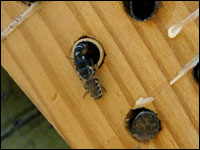
One female Megachile backs out of her nest while another sits nearby.
Looking over my back wall, I can see a large, gray, dead Palo Verde tree. I’m glad the neighbors haven’t cut it down. From closer inspections I know that its trunk and branches are riddled with holes as if peppered by a series of shotgun blasts. These holes are the handiwork of tunneling buprestid and cerambycid beetle larvae which have long since chewed their way through the bark of the dead tree and emerged as adults. These holes are vitally important for maintaining populations of native leafcutter and mason bees (called that since they trowel in mud into their nest architecture). The beetles move out and the bees move in. It always amazes just how quickly nesting female leafcutter and mason bees find the latest bee real estate in the neighborhood. Often when I first place a new bee condo under my patio eaves, I spy a female checking it out within minutes. Location, location, location! Most of these bees can’t excavate their nests in the wood but are entirely dependent upon beetle hand-me-downs. It’s important to keep dead trees and limbs in areas where bees and other wildlife live. Woodsman, spare that limb — it’s a move-in special for house-hunting bees.
You can help protect and conserve native leafcutter bees in your neighborhood by creating a bee condo out of some discarded lumber. Just drill some holes about three to five inches deep into the face of the lumber. Don’t drill all the way through the lumber. A drill bit 5/16th inch diameter (7-8 mm) is a good general-purpose size for your bee holes. Securely fasten your new bee house under the eaves against your home or a garden shed, where it’s protected from the rain. Have fun. Experiment with smaller hole sizes and see who shows up. Don’t worry about a few neat circular snips taken out of those rosebush leaves. The leafcutter bee leaf-procurement activities won’t kill your plants and you’ve donated essential building materials to a growing bee family nesting somewhere nearby. In return, they will provide you with essential pollination services for native plants and garden crops in your yard and surrounding areas. Not only that, but they can entertain you for hours as tiny but exquisitely watchable wildlife. Become a bee watcher. For some real fun, get a pair of close-focusing binoculars and really get to know them in an up-close-and-personal way. Watch ’em as closely as you like, they won’t sting you — but you may be stung by a growing curiosity to explore their fascinating ways of pollinating flowers and making a living from them.
Wednesday, 24 Sep 2003
TUSCON, Ariz.
It bee Wednesday, hump day. For once the telephone call wasn’t from an anonymous, fast-talking telemarketer, or someone from my own bank, not realizing I’m already a customer, or Qwest, Sprint, MCI, or one of several other nearly omnipresent telecommunications giants wanting to sign me up. Thankfully, the call that just ended was from my Mexican bee researcher colleague and friend, Dr. Rogel Villanueva. Rogel teaches and conducts research on stingless bee and pollen identification at the College of the Southern Frontier (ECOSUR) in Chetumal. This tropical paradise is on the coast in the Mexican state of Quintana Roo, nearly straddling the border with its neighbor, Belize, to the south. We have been planning a trip in November to Rogel’s meliponarios in various Mayan villages, in southernmost Mexico.
Until July of this year, it had been several years since I’d seen Rogel. The first time I met him was during a several-day workshop as part of PCAM (Programma Cooperativa Sobre La Apifauna de Mexico), a program sponsored by the Smithsonian, the University of Kansas, and the American Museum of Natural History in New York City, and funded largely by grants from the National Science Foundation. On that date back in 1984, I was one of a group of U.S. bee guy instructors leading taxonomic identification and ecological workshops for Mexican faculty and students. We had flown in to Cancun and then departed for Puerto Morelos and venues farther south, away from the plague of sun-baked turistas and clever entrepreneurs waiting to sign us up for Cancun timeshare property opportunities.
The PCAM workshop and its bee-collecting expeditions gave rise to another course. This is the Bee Course, which trains U.S. and foreign students in bee classification and identification and bee ecology. I’ve been an instructor for the past five years at the Southwestern Research Station, near Portal, Ariz. SWRS is a field station funded by David Rockefeller (himself a beetle enthusiast) and operated by the American Museum of Natural History.
I still have fond memories of working with that wonderful group of instructors and students. Many have remained steadfast friends. One student in that PCAM course was Dr. Gabriella Chavarria, now a program director for the National Wildlife Federation in Washington, D.C. Gaby is an expert on the taxonomy and biology of Mexican bumblebees and has done a great deal to bring foundation attention and essential funding to pollinator conservation issues. Along with Paul Growald from the Coevolution Institute in San Francisco, she is a cochair of a consortium called the North American Pollinator Protection Campaign, whose more than 70 partner organizations are dedicated to animal-pollinator and plant-pollination issues.
Dr. David Roubik of the Smithsonian Tropical Research Institute in Panama is someone I’ve had the pleasure of working with for many years, tramping through various Panamanian, Costa Rican, and Asian rainforests in search of his beloved stingless bees and metallic jewel-like orchid bees. Together, Dave and I have gently squeezed bee bellies to get refractometer readings of the sugar quality of their internal nectar loads for various bee energetic studies. Now — based upon the epic pollen identification monograph created by Rogel — Dave, Rogel, and I are eager to sample honey and pollen samples from within nests. We are interested in discovering which native and introduced plants play the most important roles in the diet breadth of the native stingless bees of Quintana Roo. We also want to find out how the invasive Africanized honey bees may be competing for limited resources with the native bees.
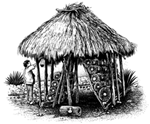
Mayan beekeeper in thatched hut, with traditional hives stacked on A-frame rack.
With funding from the CS Fund of California, my environmental company, The Bee Works, has begun a multi-year study of Mayan beekeepers and two stingless bee species (Melipona beecheii and M. yucatanica) in the forests of southern Mexico, especially in the vicinity of Felipe Carillo Puerto. Our goals are to survey beekeepers and learn the extent of the demise of beekeeping and their sacred Melipona colonies. We are producing bilingual educational guides to help beekeepers make colony transfers from traditional jobones hollow logs to box hives, and to inform them of ways to keep pesky phorid fly parasites from turning their precious bee colonies into seething masses of maggots. We want to find sustainable markets for their Melipona honey (which is delicious) and wax products, as long as we can be assured that profits go back where they belong, into the hands of the Mayan beekeepers.
We are forming a grassroots organization in Quintana Roo made up of Mayan beekeepers, along with Mexican and U.S. businessmen and scientists, to promote and enliven the ancient Mayan beekeeping traditions, conserve their sacred Melipona bees, and protect their ancient forests. We are hopeful that together we can slow or stop the loss of these living bee and plant resources, a sacred heritage of inestimable value to the modern Maya, to Mexico, and the world.
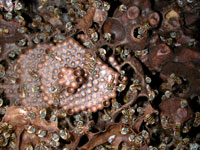
Inside the nest of Melipona beecheii.
My business partner, Jim Donovan, is an expert in GIS systems, and we hope to map the scale, extent, and pace of deforestation in the region. As it turns out, Melipona beecheii is disappearing before our eyes. The largest stingless bees of this forest (M. beecheii and M. yucatanica) nest in hollow portions of the tallest trees, Methuselah giants known as canopy emergents. Today, this tallest forest of the Yucatan Peninsula has largely disappeared. It was felled centuries ago on the Merida side of the peninsula, largely to provide masts and timbers for shipbuilding and to produce Spanish colonial mansions and churches. Fortunately, some remnants of this tall tropical forest (25-30 meters in stature) survive in patches in Quintana Roo. A recently published survey indicates that roughly 25 beekeepers near the small city of Felipe Carillo Puerto once tended more than 800 colonies of Melipona bees. Just two years ago, that number had plummeted to less than 70. We want to know the reasons for this precipitous decline.
The ancient Maya practiced the gentle art of beecraft. They recognized the different types of bees and what kinds of flowers they visited. Honey was used by their shamen, the H-men, in elaborate rituals. If they accidentally killed a bee, they reverently wrapped it in a leaf and buried it. From the Melipona honey, they created a fermented drink known as balche, still relished in the region. Beeswax was used in candles and lostwax casting of metal objects. These fascinating practices were detailed in what must have once been thousands of colorful illustrated bark fiber books created by the Maya. Today, there are only four of these original Mayan books in existence. The rest were discovered and burned by the conquering Spaniards, who viewed them as a threat to the Catholic Church. The famous Madrid Codex is housed in the anthropology museum in Madrid, Spain.

An incense burner depicting the bee god “Ah Mucen Kab” cradling honey pots.
I doubt that Mayans were as fiercely bloodthirsty a lot as they are often portrayed in books, magazines, and television documentaries. You know the Hollywood stereotypes: There are angry temple gods everywhere, just waiting for priests to appease them and guarantee a good harvest by tossing hapless virgin maidens, trussed up with gold chains of course, into the nearest sacred well, or cenote. Rather, I suspect that the ancient Maya of southern Mexico, Guatemala, Belize, and El Salvador were more like today’s compassionate Mayan beekeepers and their families, who have shared their honey harvests, stories, beliefs, and smiles with us in their far-flung villages and milpas across the Yucatan peninsula. We’ll be back in November. I can’t wait to see what sweet adventures our next trip will bring.
Thursday, 25 Sep 2003
TUSCON, Ariz.
“The evidence is overwhelming that wild pollinators are declining around the world. Most have already experienced a shrinkage of range. Some have already suffered or face the imminent risk of total extinction. Their ranks are being thinned not just by habitat reduction and other familiar agents of impoverishment, but also by the disruption of the delicate ‘biofabric’ of interactions that bind ecosystems together. Humanity, for its own sake, must attend to the forgotten pollinators and their countless dependent plant species.”
— Edward O. Wilson, Harvard University, from the foreword to The Forgotten Pollinators

In the Chihuahuan desert of southeast Arizona, a Protoxaea gloriosa bee collects nectar.
Photo: S. Buchmann
I couldn’t have stated it more presciently. The green biofabric that clothes, protects, heals, and feeds everything on land is coming apart at its seams, unraveling thread by thread as we go about our usual business of taking short-term, ecologically subsidized profits and generally not caring. At the very least, we usually don’t give flowering plants and their codependent pollinators a second thought.
For several hours this morning and for much of the previous couple of weeks, I’ve been informally polling my melittological (the study of bees) colleagues and asking them to weigh in on pollinator extinctions and the general question of rare, threatened, and endangered invertebrates. Everyone seems to agree that we have lost many birds (e.g., many of the curve-billed honey eaters that pollinated the lobelioids Clermontia and Cyanea in the Hawaiian archipelago), and some of the magnificent flying foxes, actually megachiropteran bats, from Samoa and other Pacific Islands. According to entomologists at the Bishop Museum, there may be as many as 77 species of insects that have gone extinct in the Hawaiian Islands. There are also good examples of bee extinctions from European countries, especially the United Kingdom. There are other apparent extinctions of bees from the floristically rich floral province of Western Australia, its wheat belt now a vast monocultured biological wasteland fed upon only by massive combines with insatiable appetites.
The IUCN (World Conservation Union) Red List of Threatened Species lists a total of 557 species of insects as globally threatened in 2002. The same source lists 236 U.S. animals (vertebrates plus invertebrates) as having gone extinct, with a total of 1,499 in threatened and other categories. These and other similarly disturbing statistics have prompted Scott Hoffman Black, executive director of the Xerces Society, to write a number of articles, and Canadian Dr. Peter G. Kevan of Guelph University to head the Task Force on Declining Pollination, a working group of the IUCN’s Species Survival Commission.
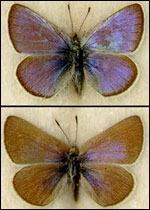
The Xerces Blue, first butterfly to go extinct.
What’s clear is that the United States has lost several species or subspecies of butterflies in recent times. The first documented butterfly extinction was the Xerces Blue (Glaucopsyche xerces), the namesake of that society dedicated to invertebrate conservation.
Those I asked were divided, however, about whether we have lost any of our native bees. Along with several Xerces staff members, and a few other “melittophiles,” I’ve set about to find out just how many bees might be so rare or threatened by anthropogenic changes to their habitats that they might be good candidates for listing under the federal Endangered Species Act.
Considering the political and legal mazes confronting those who try to get rare plants or invertebrate animals listed, it amazes me that anyone or any organization is willing to undertake an attempt. The process can take many years, it’s expensive, it’s fraught with hidden dangers, and it seems to raise the hackles on just about everyone.
Land developers in Riverside County in southern California bristle and local politicians brandish fly swatters whenever the videotape is rolling and the federally listed Delhi Sands Flower-Loving Fly (Rhaphiomidas terminatus) is mentioned. Everyone knows that the first federally protected fly stands in the way of hospitals and other instruments of human progress. Why can’t the environmentalists see that? Environmental activists cry foul, and at least one Riverside entomologist has been quoted as saying, “It’s the habitat, stupid.” He’s right, actually.

The first federally protected fly, Rhaphiomidas terminatus
The Delhi Sands Flower-Loving Fly is a unique product of evolution and has every right to be where it is, but the sad part is that in the name of progress we so readily and so easily give up and sell off precious wildland habitats, which, like an ecological Humpty Dumpty, cannot be reassembled. That humble fly, like so many other pollinators, performs unique and invaluable ecosystem services that we all ultimately depend upon.
Just as the eco-players and consultants who assembled the artificial biomes within Arizona’s Biosphere II — a $200 million experiment of life under glass — found out, it’s not easy playing creator, or natural selection, when designing a world from scratch. Just having some of the bio-ingredients isn’t enough when you don’t have the crucial recipes nor any idea how long to bake your ready-mix world. I know because it was my job to add the bee pollinator “seasoning” ingredients to that biotech world. Eventually, exotic ants, cockroaches, and weedy plants ruled the place. Similar simplifications of habitats and loss of biotic diversity are happening all over the world. Perhaps it’s because we are too arrogant or too naive, thinking that Homo sapiens is ecologically omniscient and can effectively manage any living system given enough committee meetings or money. The truth is that we simply don’t know enough about how all the organisms interact with one another in complex natural ecosystems. What happens when one insignificant fly or a few 4-mm-long nondescript sweat bees go extinct? In an oft-used metaphor, are we losing the biological rivets that are holding our eco-plane together, until too many have been lost and the plane falls from the sky?
Before the Hawaiian Islands were overpopulated with people and their coterie of camp followers, including various feral rats, cats, cattle, wild boar, invasive plants, and others too numerous to mention, they were a showcase of evolutionary adaptive radiations. Few other places on earth can boast such an amazing biota, which had evolved in just a few million years on barren volcanic islands risen from the depths.
Before the arrival of the Polynesian double-hulled canoes, all the islands’ animals and plants were unlikely winners in a biotic long-distance lottery. They had flown, swum, ballooned in the jet stream, or hitchhiked in mud on birds’ feet to get there in the first place. Hawaii is more than 2,000 miles from the nearest continental source area, and only 500,000 years old, the world’s most isolated chain of high islands. Yet from such humble beginnings wondrous forms evolved, including a diverse assemblage of flies in the genus Drosophila (responsible for most of what humankind knows about genetics) and the curve-billed honey-eater birds.
One even less well-known group consists of the 60 species of Hylaeus (Nesoprosopis) bees, the only bees endemic to the Sandwich Isles. These bees have recently been monographed by Drs. Howell Daly and Karl Magnacca. Of the 60 species, at least 11 species have not been collected or seen since 1989 or earlier. The species at greatest risk are the ones that live at the lowermost elevations, habitats that have all but been destroyed by urban sprawl or been overtaken by a choking green blanket of weeds. Some of these lowland inhabiting Hylaeus species are likely extinct.
Other bees on the North American mainland are so rare that they have only been collected once or twice, from the original holotype or other specimens in the type series. What do we do with such species, or the case of errants just crossing the U.S. border in Arizona or Texas from Mexico? In the first case, these bees (like the parasitic bee genera Holcopasites or Oreopasites) may be naturally exceedingly rare across their range, therefore rarely encountered bees on already rarified hosts. In the latter example, some of these rare bees may be fairly common and not automatically threatened in other habitats in northern Mexico.
I personally believe that we have lost not just species of butterflies, but bees as well in the continental United States. In some cases, it will take intensive new multiyear sampling and mining of historical data, the dried pinned specimens in museum unit trays, to find out. In other cases, we may never know because the extinctions likely occurred hundreds of years ago, before anyone noticed. Whatever the expense and the risks, it’s worth such efforts to find out more about the fate of our champion pollinators, America’s native bees.
Friday, 26 Sep 2003
TUSCON, Ariz.
This is my final entry of the week, my fifth essay on various entomological and conservation-oriented topics. Sherry Bosse at Grist had contacted me after reading the “Small Matters” article by William Stolzenburg in the Spring 2003 issue of The Nature Conservancy Magazine about the lack of attention given the not-so-charismatic microfauna, the invertebrates. I imagine that Sherry was intrigued, or perhaps amused, by recounted tales of my driving a Toyota pickup truck around the back roads of Tucson, Ariz., conducting “impact collecting” of bees and other pollinators that stuck to my radiator. Well, actually, it was a bit more quantitative and scientific than that. I used Varroa mite-detection sticky boards to catch my hapless prey items. I assume that those were the reasons she invited me to contribute a week’s worth of diary entries to Grist Magazine.
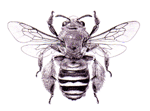
The cactus bee (Diadasia rinconis).
Photo: Elaine Hodges, Smithsonian Institution.
It’s not a big secret that most cars, trucks, and motorcycles are excellent filter feeders as they cruise their way through what amounts to a rich veritable aerial plankton of insect life — just think of those bug splats on your windshields. There is even a wonderful, cheeky insect field guide called That Gunk on Your Car by Mark Hostetler. It has plenty of serious information about the natural history of many common North American insects. I’ve been collecting data on the impact (pun intended) of our nations’ hundreds of thousands of miles of roadways, literally killing lanes for pollinators and other insects. It’s a topic that I’ll soon be addressing in upcoming scientific articles.
Whatever Sherry’s reasons, I’m delighted and honored to have been asked to contribute to this lively online info-place exchange medium that is Grist Magazine. This magazine gives a unique glimpse into the daily lives, perspectives, and thinking of biologists, policy makers, activists, conservation biologists, and others. Thank you, Grist, for all you do.
When I took a break to write this final essay, it wasn’t from pulling insect carcasses off my vehicular sticky boards, although eyestrain was involved. I’d just spent more than an hour peering into my stereo binocular microscope trying to identify a medium-sized native bee that I collected earlier this year from another type of insect trap used in my research. It seems that bees, some flies, and wasps are attracted in amazing numbers and diversity to yellow, white, and blue Solo brand plastic picnic bowls filled with water and a few drops of dishwashing detergent, when set out on the ground. Little does the company know that they’ve created one of the most effective insect traps yet devised! I’m one of a group of a dozen or so scientists in the U.S. presently fine-tuning this collecting technique so that it can be used as a standardized sampling protocol for biodiversity assessment of our native bee fauna.
I twisted the micromanipulator resting on the stage of my microscope. It held the bee specimen so that it could be moved into any desired position. The wing venation on the dried and pinned specimen (sometimes I like to think of them as “shish-ka-bees”) came into focus. I knew I had a male bee since it had 13 antennal flagellomeres and no scopal pollen transport apparatus on its hind legs. Its long antennae told me it was likely a male eucerine, one member of a bewilderingly diverse group of bees, sometimes known informally as “digger bees.” These bees were formerly placed in the family Anthophoridae, but recently moved by the King Bee himself, Charles Michener of the University of Kansas, the world’s authority on bees, to the family Apidae. Finally, couplet after couplet, I slogged my way through the dichotomous key, thankfully a nicely illustrated one. It seems that my unknown bee belonged to the huge genus Melissodes, and not a related genus like Synhalonia or Tetralonia, others in the tribe Eucerini. It will take even more hours at my microscope keying it down to subgenus, then species. I longed for the days when the real expert, in this case the true eucerine master, Wally LaBerge, would have made these species identifications for me.

A fast-flying desert bee, Centris pallida.
Photo: Paul Mirocha.
We have a problem. It’s not easy to get bees, or any insects — except perhaps butterflies and large silk moths — identified to genus or species. Some scientists have rightly called this the global taxonomic impediment. How can we preserve the earth’s biota when we haven’t even given most of its creatures a scientific name! There are 4,000 species of native bee species in the United States alone. This always comes as quite a shock to audiences when I’ve mentioned this in public lectures. When queried, they usually can think of only 4 kinds of bees: honey bees, bumblebees, carpenter bees, and sweat bees, leaving plenty more literally flying under the radar of the general public. Sadly, there are probably fewer than 20 U.S. scientists who can identify almost any commonly encountered bee to genus and species. There is no equivalent to birding; there is no Peterson’s guide for bees.
All of these species perform essential yet unaccounted for ecosystem services including pollination, bioturbation, and nutrient cycling. There are nearly 20,000 described species of bees worldwide. In my own research I’ve discovered plenty of species new to science, without much effort. There may be as many as 30,000 bee species alive today. Some of them are already disappearing forever under the plow, swaths of invasive African grasses, or asphalt parking lots before they’re given a formal scientific description.
Although there are no field guides to bees of the United States, other than arcane taxonomic monographs, there are some pioneers exploring other ways to get the job done. Dr. John Pickering of the University of Georgia has pioneered an interactive computerized key utilizing illustrations and photos for use by naturalists, students, and scientists. Recently, his Discover Life project published a key to the bumblebees of the United States. A semi-automated approach is being taken by an Arizona and U.K. company called Morpho, Inc., which produces pattern recognition software (DAISY) for this task. In this system, the right forewing of an unknown insect is digitized and submitted to the program, which then performs the i.d. task. Thus, there is hope, even with a dwindling population of professional taxonomists, that the rest of us may soon have powerful tools enabling us to recognize our amazingly diverse guilds of native bee pollinators. Such tools should help ease the workload on museum taxonomists, freeing them from routine and boring i.d.’s of common insects, allowing them to get on with the heady task of describing new species, and revising genera.
